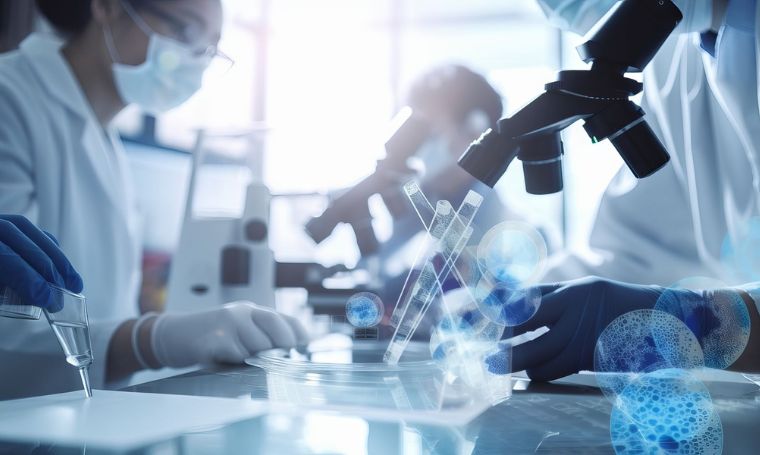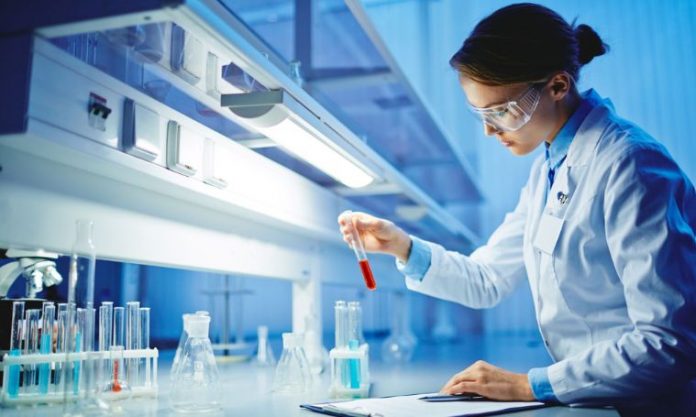Chemical reactions and techniques categorized as click chemistry tools are utilized in diverse scientific and technological fields for the rapid, selective, and efficient synthesis of complex molecules, surface functionalization, and biomolecule modification. These tools are recognized for their high efficiency, selectivity, and user-friendliness.
Click chemistry was first coined by K. Barry Sharpless in 1998 as a concept for a set of chemical reactions that are highly modular, easy to perform, and capable of generating products in high yield with minimal by-products. The term “click” chemistry was coined to emphasize the quick joining of small, reactive building blocks to develop larger, more complex structures reliably and predictably.
Examples Of Click Chemistry Tools
Click chemistry tools have significantly advanced many fields of science. Below are a few examples of click chemistry tools, with many other reactions and techniques falling under the umbrella of click chemistry.
- Copper-Catalyzed Azide-Alkyne Cycloaddition (CuAAC)
This chemical reaction utilizes an azide and an alkyne in the presence of a copper catalyst, usually copper (I) or copper (II) salts. The reaction is known for its high efficiency and is commonly employed in synthesizing complex molecules, surface functionalization, and biomolecule modification.
- Strain-Promoted Azide-Alkyne Cycloaddition (SPAAC)
This reaction involves an azide and an alkyne without needing a catalyst, relying instead on the strain or other activating groups. SPAAC is a bioorthogonal click reaction that can be performed in complex biological systems without interfering with native biomolecular interactions. It has been widely used for biomolecule labeling, bioconjugation, and drug delivery applications.
- Photo-Click Chemistry
This click chemistry approach involves using light-induced reactions, such as photoactivated cycloadditions or photochemical crosslinking, to achieve selective and rapid modification of molecules or surfaces, often utilizing PEG linkers as versatile spacers. Photo-click chemistry is beneficial for spatial and temporal control of chemical reactions, and it has been used in diverse areas, including materials science, drug delivery, and bioconjugation.
- Diels-Alder Reaction
The Diels-Alder reaction, a well-known click chemistry reaction, entails the cycloaddition of a diene and a dienophile to generate a cyclic product. This reaction is highly valuable for synthesizing complex molecules with multiple functional groups and has found extensive applications in organic synthesis and materials science.
- Tetrazine-Trans-Cyclooctene (TCO) Click Chemistry
This reaction involves a tetrazine and a TCO, a strained cyclic alkene. This highly selective reaction has been used for bioorthogonal labeling of biomolecules, drug delivery, and other biomedical applications.
- Staudinger Ligation
This click chemistry reaction involves the reaction between an azide and a phosphine to form a stable triazole product. Staudinger ligation is a bioorthogonal reaction that has been used for the selective labeling of biomolecules and the development of bioconjugates.
Applications Of Click Chemistry Tools

Click chemistry tools have found diverse applications in various fields of science and technology, including pharmaceuticals, materials science, and biotechnology, and they have important implications for businesses operating in these areas. Some key applications of click chemistry tools include:
- Drug Discovery And Development
Click chemistry has been widely used in drug discovery and development to rapidly synthesize and modify drug candidates. Click reactions allow for efficient and selective modification of drug molecules, enabling the creation of drug conjugates, prodrugs, and drug delivery systems. Click chemistry has also been employed in synthesizing drug libraries for high-throughput screening and developing drug delivery systems with controlled-release properties.
- Materials Science
Materials science has extensively used click chemistry to synthesize and functionalize polymers, nanoparticles, coatings, and surfaces. Click reactions enable precise control over materials’ structure, size, and functionality, leading to advanced materials with tailored properties for various applications, such as sensors, catalysis, coatings, and drug delivery systems.
- Bioconjugation And Biomolecule Labeling
Through bioconjugation reactions, click chemistry tools have been widely used to select biomolecules, such as proteins, peptides, nucleic acids, and carbohydrates. Click reactions allow for site-specific labeling of biomolecules without affecting their native function, enabling the creation of bioconjugates for various applications, including diagnostics, therapeutics, and imaging.
- Surface Functionalization
Click chemistry has functionalized surfaces with desired functional groups or biomolecules, such as metals, glass, polymers, and nanoparticles. Click reactions enable efficient and selective modification of surfaces, creating tailored interfaces with improved properties, such as biocompatibility, adhesion, and chemical reactivity. Surface functionalization using click chemistry has applications in coatings, sensors, microarrays, and drug delivery systems.
- Bioorthogonal Chemistry
Bioorthogonal chemistry reactions are commonly employed as click chemistry tools, allowing for selective and rapid modification of biomolecules in complex biological systems without disrupting native biomolecular interactions. These reactions have enabled diverse applications, such as bioconjugation, protein engineering, and drug delivery in living organisms.
- Diagnostic Tools
Click chemistry has been employed in developing diagnostic tools, such as bioassays, biosensors, and imaging agents. Click reactions allow for the efficient and selective attachment of signaling molecules, such as fluorophores, enzymes, or nanoparticles, to biomolecules or surfaces, creating sensitive and specific diagnostic tools for various diseases, infections, and conditions.
- Click Chemistry In Nanotechnology
It has been extensively used in nanotechnology to synthesize and modify nanoparticles, nanocomposites, and nanodevices. Click reactions enable precise control over nanoparticles’ size, shape, and surface properties, allowing for the creation of advanced nanomaterials with unique properties for applications in drug delivery, imaging, diagnostics, and other areas.
These are just a few examples of the wide-ranging applications of click chemistry tools. Click chemistry has been employed in numerous fields of science and technology, offering efficient, selective, and easy-to-use methods for synthesizing and modifying molecules, surfaces, and biomolecules, enabling advancements in various areas of research and technology.
Benefits Of Click Chemistry Tools
As previewed above, click chemistry tools offer several benefits that make them widely used in various fields of science and technology. Some key benefits of click chemistry tools include:
- Efficiency
Click reactions are known for their rapidity and high yield, facilitating swift synthesis and modification of molecules, surfaces, and biomolecules. The exceptional efficiency of click chemistry tools streamlines synthesis processes, making them highly desirable for applications requiring high throughput or large-scale production due to time-saving benefits.
- Selectivity
Click reactions are highly selective, meaning they occur specifically between the click chemistry partners, minimizing side reactions and unwanted cross-reactivity. This selectivity allows for precise and controlled modifications, ensuring the desired functionalization without compromising the target molecules’ or materials’ integrity or properties.
- Versatility
Click chemistry tools are versatile, as they can synthesize and modify a wide range of molecules, surfaces, and biomolecules, from small molecules and polymers to nanoparticles, proteins, nucleic acids, and carbohydrates. This versatility supports diverse applications in drug discovery, materials science, bioconjugation, surface functionalization, and nanotechnology.
- Orthogonality
Offering orthogonality, click chemistry tools can be performed simultaneously or sequentially without interference. This enables the creation of complex and multi-functional systems by combining different click reactions or using multiple click reactions in a single process, providing enhanced flexibility and versatility in designing and modifying molecules, surfaces, and biomolecules.
- Bioorthogonal
Some click reactions, like SPAAC and tetrazine-TCO reactions, are explicitly designed for bioorthogonal chemistry, meaning they can occur in complex biological systems without disrupting native biomolecular interactions. This allows for selective and specific modifications of biomolecules in living organisms, enabling applications such as bioconjugation, protein engineering, and in vivo drug delivery.
- Mild Reaction Conditions
Click reactions typically take place under mild conditions, like room temperature, neutral pH, and aqueous environments, which are suitable for many biological systems and delicate molecules. This allows for the modification of sensitive biomolecules, including proteins and nucleic acids, without compromising their stability or function.
- Easy-To-Use
Click chemistry tools are user-friendly, featuring simple reaction setups and easy-to-handle reagents. This makes them accessible to a wide range of researchers and practitioners, regardless of expertise level, and allows for efficient incorporation of click reactions into existing synthetic or modification protocols.
- Modular And Expandable
Click chemistry tools offer a modular approach, allowing for the stepwise assembly of complex structures by combining different click reactions or using click reactions as building blocks. The modular and expandable nature of click chemistry creates diverse and intricate architectures, providing enhanced flexibility and versatility in designing and modifying molecules, surfaces, and biomolecules.
- Cost-Effective
Typically using readily available and affordable starting materials, reagents, and catalysts, click chemistry tools are cost-effective compared to other synthetic methods. This makes click chemistry an attractive option for large-scale synthesis or industrial applications where cost considerations are crucial.
These advantages have made click chemistry popular in various fields of science and technology, enabling advancements in drug discovery, materials science, bioconjugation, surface functionalization, nanotechnology, and other areas.
Practical Tips And Guidelines For Using Click Chemistry Tools
Best practices and guidelines are essential for successful outcomes when working with click chemistry tools. Here are some practical tips and guidelines for using click chemistry tools effectively:
- Choose Appropriate Click Reactions
Various click reactions are available, such as CuAAC, SPAAC, thiol-ene reaction, and others. Select the appropriate click reaction based on your specific requirements, such as the functional groups in your substrates, reaction conditions, and desired outcome.
- Optimize Reaction Conditions
Click chemistry reactions often require specific reaction conditions, such as catalysts, temperature, solvent, and reactant concentrations. Optimize these reaction conditions to achieve the best results while considering your substrates’ compatibility and the click reaction’s limitations.
- Consider Bioorthogonality
If you are working with click chemistry tools in a biological context, consider the bioorthogonality of the click reaction. Choose bioorthogonal click reactions that do not interfere with cellular processes or biomolecules to ensure minimal off-target effects.
- Pay Attention To Compatibility
Ensure compatibility of click partners with your substrates or materials. Consider factors such as steric hindrance, electronic effects, and reactivity of functional groups, and select click partners that are compatible with your specific substrates or materials.
- Optimize Reactant Concentrations
Click reactions are often highly efficient and selective, but optimizing the concentrations of click partners can further enhance their performance. Too high or too low concentrations of reactants can affect the reaction kinetics, yield, and selectivity, so optimizing the concentrations for your specific click reaction is essential.
- Use Appropriate Catalysts
Some click reactions require catalysts, such as copper catalysts for CuAAC. Choose appropriate catalysts compatible with your substrates and reaction conditions and follow the recommended guidelines for their use to ensure optimal results.
- Consider Scalability
If you plan to scale up your click chemistry reactions, consider the scalability of the reaction. Factors such as mass transfer limitations, reaction times, and reproducibility can affect the scalability of click reactions, so optimize your reaction conditions accordingly.
- Handle Reagents Safely
Click chemistry reactions can involve toxic or hazardous reagents, catalysts, or solvents. Follow appropriate safety guidelines, handle reagents safely, and dispose of them properly according to local regulations.
- Characterize Reaction Products
Adequately analyze the products of click chemistry reactions using appropriate analytical techniques, such as spectroscopy, chromatography, or mass spectrometry. This will enable a thorough characterization of the obtained product, ensuring that it meets the desired specifications.
- Troubleshoot And Optimize
Click chemistry reactions may not always yield the desired results on the first attempt. If you encounter challenges or limitations, troubleshoot and optimize the reaction conditions, such as changing the catalyst, solvent, or concentration, to achieve better results.
- Stay Updated With The Latest Research
Using click chemistry tools effectively requires careful consideration of the specific requirements, limitations, and best practices for each click reaction. Click chemistry is a rapidly evolving field, and new click reactions, reagents, and techniques are constantly being developed. Stay updated with the latest research, attend conferences, and read scientific literature to stay informed about the latest advancements in click chemistry tools.
Conclusion
Click chemistry tools have emerged as a powerful arsenal in the chemist’s toolbox, enabling efficient and selective reactions with broad applications across diverse fields. While challenges and limitations exist, researchers continue to overcome these hurdles by optimizing reaction conditions, developing new click reactions, and staying updated with the latest research.
As the field of chemistry continues to evolve, click chemistry tools are expected to play a pivotal role in driving innovation and shaping the future of chemical research and its practical applications.


























